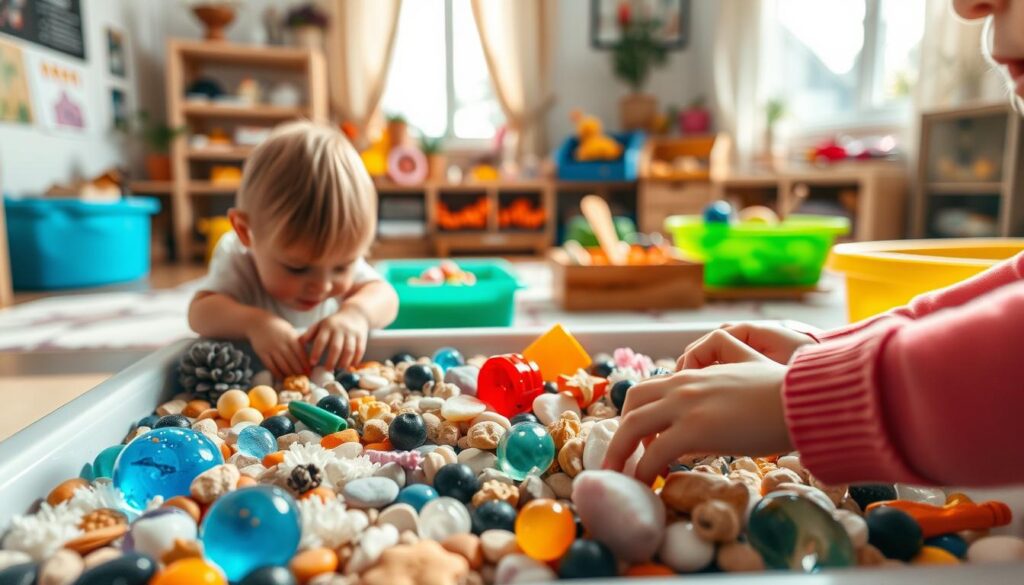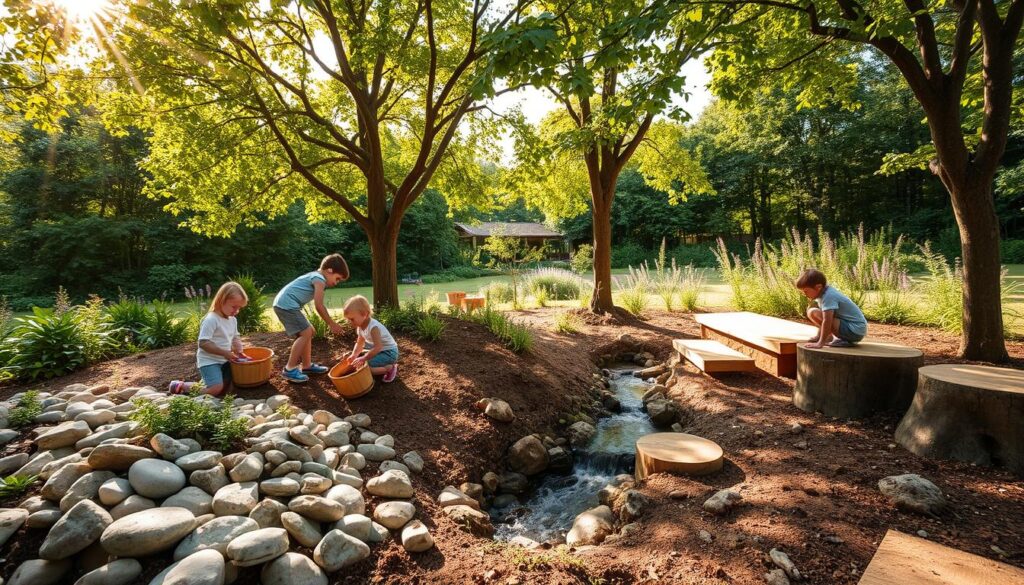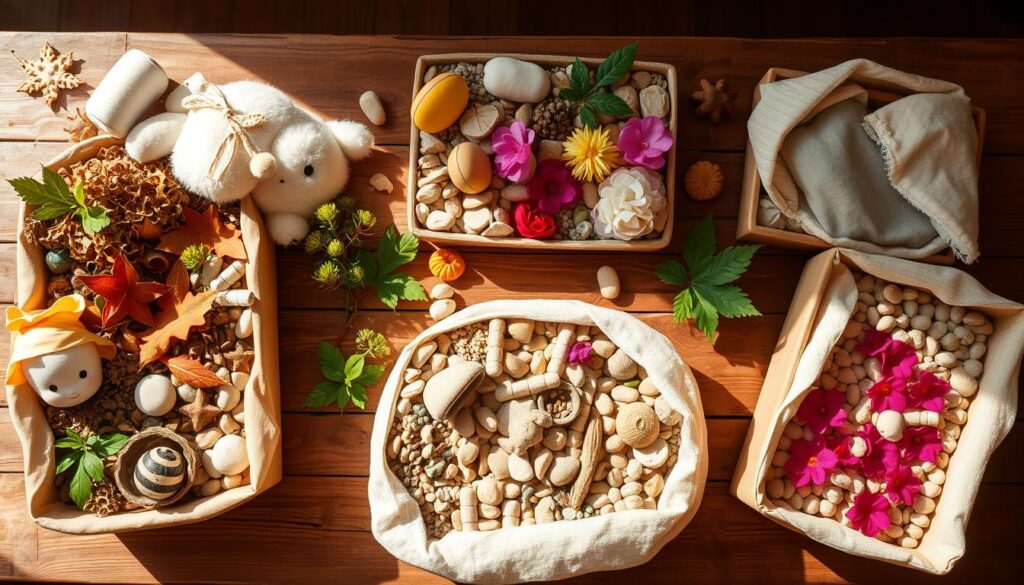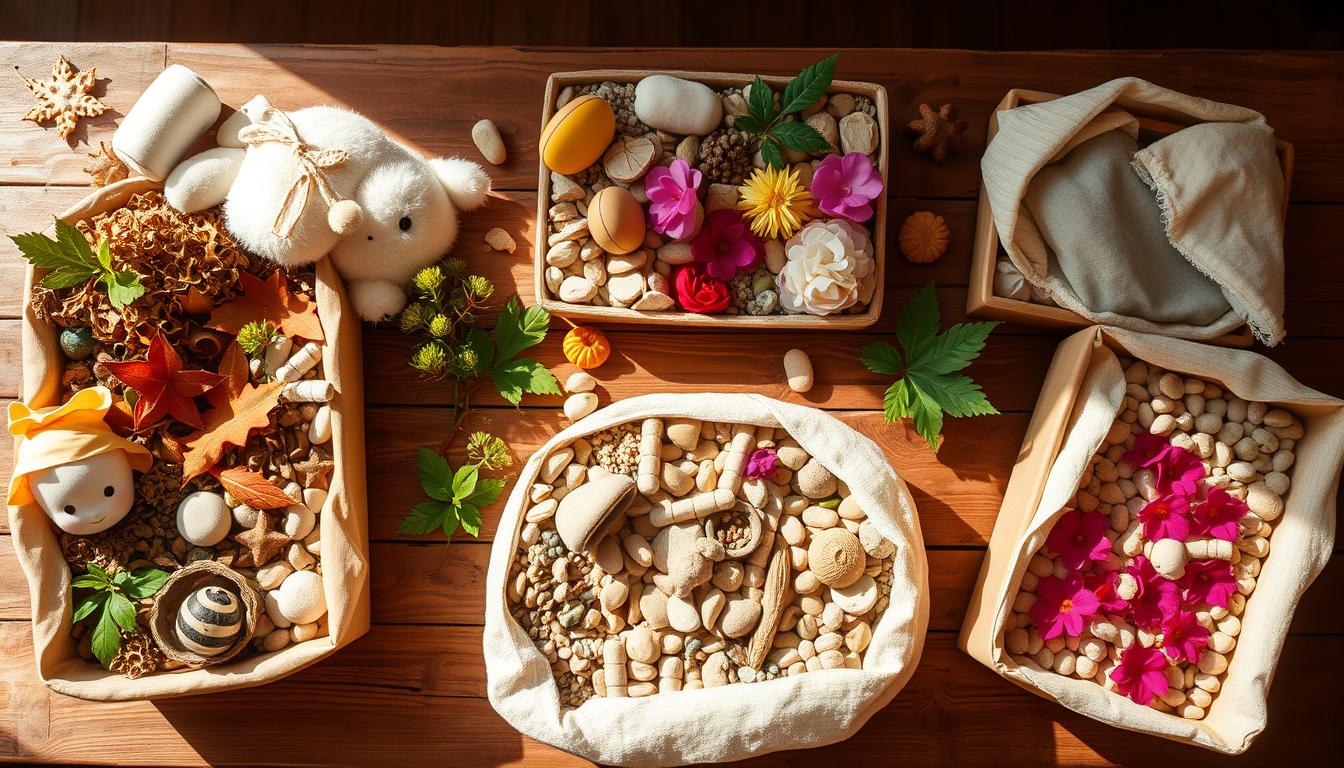Welcome to the world of sensory play, where kids can explore and learn through fun activities. Sensory play helps kids grow physically, mentally, and socially. It boosts their senses, hand-eye coordination, and fine motor skills. It also encourages creativity and imagination.
Sensory play is key for toddlers. It helps them understand and explore their world. Activities like playdough, sand, and water play are fun ways for kids to learn. By making sensory play a part of their day, parents and caregivers help kids build a strong base for learning and success.

Introduction to Sensory Play
Sensory play is crucial for kids’ development. It’s important to give them many sensory experiences. This helps them grow and thrive. From sensory play for toddlers to kids’ activities, there are endless ways to engage them in learning through play.
Key Takeaways
- Sensory play contributes to physical, cognitive, and social-emotional growth in children.
- Sensory play for toddlers helps develop their senses, hand-eye coordination, and fine motor skills.
- Kids’ sensory activities foster creativity and imagination.
- Sensory play helps children develop a strong foundation for future learning and success.
- Parents and caregivers can incorporate sensory play into their daily routine to support childhood development.
- Sensory play is a fun and interactive way for children to learn and develop new skills.
Understanding the Power of Sensory Play in Child Development
Sensory play is key for kids’ growth. It helps them use their senses like touch, taste, smell, hearing, and sight. This makes them understand and move around better.
Playdough, sand, or water are great for indoor sensory play. Kids can explore and learn from these materials. For example, playdough improves hand strength and touch. Sand helps with texture and density.
- Improved cognitive growth through sensory exploration
- Enhanced physical development through sensory play activities
- Increased social-emotional learning opportunities through sensory play
Many indoor activities can help, like sensory bins, bottles, and tables. Adding sensory play to daily life helps kids build a strong base for learning and success.
Essential Materials for Creating Sensory Play Experiences
Creating engaging sensory play experiences starts with the right materials. Sensory bin ideas can be simple, like filling a bin with rice, beans, or sand. Add small toys or objects for kids to find. Water and soap can also make a fun, interactive water-based activity.
Using recycled items is another creative way to make sensory materials. It boosts creativity and helps the environment. Old cardboard tubes, fabric scraps, and plastic containers are great examples.
- Rice, beans, or sand for sensory bins
- Water and soap for water-based activities
- Recycled household items like cardboard tubes and fabric scraps
- Kids’ sensory materials like play dough and slime
Having these materials ready lets you create many sensory play experiences. They suit different ages and abilities. Always watch over kids during play and help when needed. With creativity and imagination, you can make sensory play fun for everyone.
Indoor Fun Sensory Play Activities You Can Start Today
Indoor sensory play is great for kids’ learning and growth. You can create fun activities that use touch, hearing, sight, smell, and taste. These activities are perfect for rainy days or when you want to keep kids entertained at home.
Try making a texture play area with playdough, slime, or sand. You can also make sound games with homemade instruments like shakers filled with beads or rice. For visual fun, set up a light table or a sensory bin with water and food coloring.
Other fun ideas include smell and taste adventures like baking cookies or making fruit salad. You can also make a sensory bin with rice, beans, or pasta and hide small toys for kids to find. These activities are not only fun but also help kids develop their senses and learn new things.
Indoor sensory play helps kids improve their fine motor skills, hand-eye coordination, and problem-solving. It also boosts their social-emotional skills like sharing, taking turns, and cooperation. By adding indoor sensory play to your daily routine, you can make learning fun and engaging for your kids.
Outdoor Sensory Play Ideas for Nature Connection
Spending time outdoors is key for a child’s growth and happiness. Nature sensory activities let kids connect with nature. They can explore different textures, sounds, and sights that excite their senses. Simple activities like playing in a sandbox or mud pit, or exploring a park or forest, are great.
Some fun outdoor sensory play ideas include going on a nature walk. Kids can collect leaves, rocks, and other natural items. They can also do a scavenger hunt to find specific things in nature. Bird watching is another activity that sharpens their hearing and observation skills.

Adding nature sensory activities to their daily lives helps kids love nature more. It also supports their healthy growth. Here are more ideas for outdoor sensory play:
- Creating a water play area, like a splash pad or small pond, for kids to play with water
- Planting a garden, where kids can learn about plants and their textures, smells, and tastes
- Going on a nature sound walk, where kids can listen to and identify different sounds in nature
By giving kids chances for outdoor sensory play, we help them bond with nature. It’s a great way to support their growth. So, let’s get outside and start exploring today!
Water-Based Sensory Activities for Hot Days
As the temperature rises, water sensory play is perfect for keeping kids cool and engaged. During summer sensory activities, water-based play is key for learning and fun. You can set up a water play area with just a tub, water, and some toys or sponges.
Water sensory play boosts fine motor skills, hand-eye coordination, and creativity. For instance, a splash play station with a water table or a large container filled with water and soap is both fun and educational.
- Splash play stations with water guns and sponges
- Ice exploration games that combine science and fun
- Water transfer activities that enhance fine motor skills
When doing water sensory play, safety is crucial. Always watch over children during water play. Make sure they wear the right clothes and stay protected from the sun. Adding summer sensory activities to your child’s day helps their growth and keeps them cool and happy during the summer.
DIY Sensory Bins and Tables
Creating DIY sensory bins and tables is a great way to encourage kids to explore. With a bit of creativity, you can create a space that sparks their imagination. You can make a simple ocean bin with blue rice, seashells, and toy fish. Or, you can make a farm bin with dried beans, corn, and toy animals.
DIY sensory tables offer a bigger and more interactive space. You can make a water play area with cups, buckets, and water wheels. Or, a sand station with different textures and tools. The goal is to provide a variety of textures, colors, and objects for kids to explore.
Some popular sensory bin ideas include:
- Space-themed bin with moon sand, glow-in-the-dark stars, and small toy astronauts
- Jungle-themed bin with green rice, small toy animals, and artificial leaves
- Construction-themed bin with sand, small toy trucks, and construction tools
When setting up DIY sensory tables, think about the age and interests of the kids. Younger kids might enjoy a simple water play area or sand table. Older kids might like slime-making or sensory art projects. With creativity and planning, you can make a sensory play space that’s both fun and educational.

Seasonal Sensory Play Activities to Try Year-Round
As the seasons change, so do the chances for seasonal sensory play. Each season offers unique sights, sounds, and feelings for sensory activities. By embracing these changes, you can create fun and educational experiences for kids.
Some examples of seasonal sensory play activities include:
- Collecting leaves and pinecones in the fall to create a nature-inspired sensory bin
- Making snowflakes and ice sculptures in the winter to explore texture and temperature
- Planting a garden in the spring to experience the sights and smells of growth and blooming
- Creating a water play station in the summer to cool off and explore fluid dynamics
These activities can be adjusted for different ages and abilities. They can also be tailored to meet specific learning goals or themes. By adding sensory activities by season to your play routine, kids can develop a deeper love for nature. They will also grow curious and full of wonder.
| Season | Sensory Activity | Learning Objective |
|---|---|---|
| Spring | Planting a garden | Exploring growth and blooming |
| Summer | Creating a water play station | Exploring fluid dynamics |
| Fall | Collecting leaves and pinecones | Exploring texture and nature |
| Winter | Making snowflakes and ice sculptures | Exploring temperature and texture |
Safety Guidelines and Best Practices for Sensory Play
When it comes to sensory play, sensory play safety is key. It’s important to follow guidelines and best practices for a safe and fun experience. This means choosing the right materials, watching children closely, and keeping the area clean.
Some important things to remember for sensory activity guidelines are:
- Use materials that are safe and won’t cause allergic reactions.
- Stay away from small parts that could be a choking hazard.
- Always watch children during sensory play to avoid accidents.
- Make sure children wash their hands before and after playing.
By following these tips, you can make sensory play safe and enjoyable for kids. Always put sensory play safety first and take steps to prevent accidents.
Being careful with sensory activity guidelines helps make sure everyone has a good time. It’s all about safety and fun.
Adapting Sensory Activities for Different Age Groups
Children grow and change, so we must adjust sensory play for each age. This keeps sensory play fun and helpful for everyone. We should think about what each age group needs, from babies to kids in school.
Infants start with simple things like textures, sounds, and smells. As they get older, activities get more complex. Older kids can do things like make art or do science experiments.
Here are some tips for adapting sensory activities for different age groups:
- Infants (0-12 months): Focus on texture, sound, and smell exploration
- Toddlers (1-3 years): Incorporate playdough, sand, and water activities
- Preschoolers (3-5 years): Introduce more complex materials and projects
- School-age children (6-12 years): Encourage independence and creativity in sensory play
By changing sensory play for each age, we give kids a great experience. It helps them grow and stay happy. Always watch over them and make sure they’re safe. Be creative in making sensory play fit each child’s needs and interests.
Conclusion: Embracing the Journey of Sensory Discovery
As we wrap up this guide on fun sensory play for kids, remember the journey never ends. Each child’s path of discovery is unique, filled with wonder and joy. By embracing this journey, we help them love learning and appreciate the world.
Activities like playing in water tables, making sensory bins, or exploring outdoors offer endless chances to discover. By following the tips in this guide, you can make sure your child’s play is safe and fun. It will also meet their developmental needs.
So, let’s start exploring! Enjoy the journey, celebrate the moments, and hold onto the memories. Sensory play is more than learning; it’s a doorway to a world of wonder and endless possibilities.
FAQ
What is sensory play, and how does it benefit child development?
Sensory play involves activities that use a child’s senses like touch, sight, and smell. It’s key for growing physical skills, thinking, and learning about feelings and social interactions.
What materials are needed for creating sensory play experiences?
You’ll need different textures like sand and water, and soap for water play. Using items from home can also spark creativity and help the environment.
What are some indoor sensory play activities that can be easily set up at home?
Indoor play can include making playdough and slime, playing with homemade instruments, and exploring light and color. You can also try cooking and baking for smell and taste adventures.
How can I incorporate outdoor sensory play and nature connection?
Outdoor play can be about touching nature, like mud, and listening to birds. You can also go on walks and scavenger hunts. Being in nature is good for kids’ growth and happiness.
What are some water-based sensory activities for hot days?
For hot days, try splash play, ice games, and water activities. These are fun and help with fine motor skills. Always keep kids safe, especially young ones.
How can I create DIY sensory bins and tables?
DIY bins and tables are for kids to explore. You can make themed bins, like ocean or farm, and sensory tables for water or sand. Tailor these to fit different ages and interests.
What are some seasonal sensory play activities to try year-round?
Try activities like collecting nature in spring, outdoor fun in summer, exploring textures in fall, and winter sensory play. Each season offers new ways to engage kids’ senses and connect with nature.
What safety guidelines and best practices should I follow for sensory play?
For safety, choose materials right for kids’ ages, watch them closely, and clean up well. Following these tips makes sensory play safe and enjoyable for everyone.
How can I adapt sensory activities for different age groups?
It’s important to adjust activities for each age group. This ensures kids stay interested and challenged, from babies to school kids.
